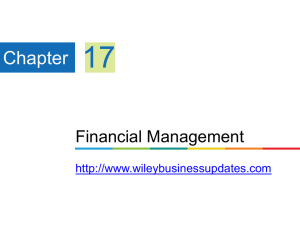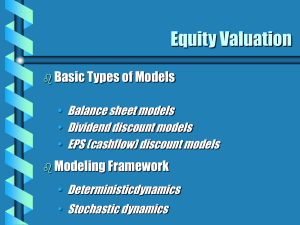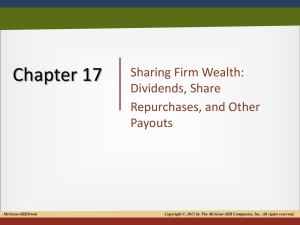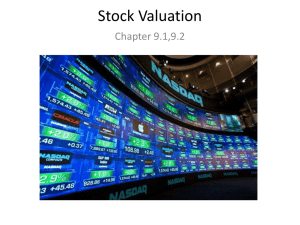ppt
advertisement
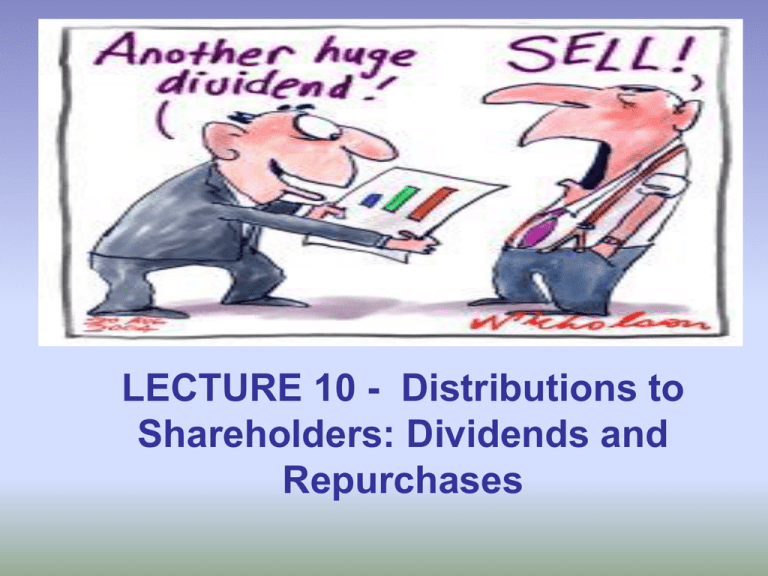
LECTURE 10 - Distributions to Shareholders: Dividends and Repurchases What is “distribution policy”? The distribution policy defines: The level of cash distributions to shareholders The form of the distribution (dividend vs. stock repurchase) The stability of the distribution 2 3 How dividends are paid Cash dividends: Payment of cash by the firm to its shareholders The payment of cash by the firm to shareholders, is declared by the board of Directors on the declaration date The dividend is paid on the payment date to all shareholders of record as of the record date (which is usually 2-3 weeks prior to the payment date) The record date is the date on which holders of record are designated to receive a dividend To be a shareholder of record, and thus receive a dividend, one must have bought the stock before the exdividend date. The ex-dividend date is 2 business days before the record date 4 Timeline of dividend payments 2 business days Declaration Date Ex-dividend Date stock trades “cum dividend” Record Date 2-3 weeks Payment Date stock trades “ex dividend” The stock price drops by about the amount of the dividend on the ex-dividend date. To be more precise, the stock price falls by the after-tax value of the dividend (difficult to measure). 5 Ex-dividend price drop (ignoring taxes) 6 Dividend yields for selected companies http://www.dividenddetective.com/big_dividend_list.htm http://www.indexarb.com/dividendYieldSorteddj.html 7 Dividend yields for selected industries Industry Div. Yield % Airline Software & Programming Biotechnology & Drugs Restaurants 0.2 0.6 0.3 1.3 Chemical Manufacturing Paper & Paper Products Electric Utilities 2.0 2.3 4.3 Tobacco Source: Yahoo Industry Data 5.7 8 General Motors – Dividends 20 10 0 -10 -20 -30 -40 -50 -60 -70 -80 1993 1995 1997 1999 2001 2003 2005 2007 Special Dividend DPS EPS 9 Caterpillar – Dividend Policy 6 5 4 DPS EPS 3 2 1 0 1993 1995 1997 1999 2001 2003 2005 2007 10 Do investors prefer high or low payouts? There are three theories: Dividends are irrelevant: Investors don’t care about payout. Bird-in-the-hand: Investors prefer a high payout. Tax preference: Investors prefer a low payout, hence growth. 11 Dividend irrelevance theory Investors are indifferent between dividends and retention-generated capital gains. If they want cash, they can sell stock. If they don’t want cash, they can use dividends to buy stock. Modigliani-Miller support irrelevance. Theory is based on unrealistic assumptions (no taxes or brokerage costs), hence may not be true. Need empirical test. 12 Bird-in-the-hand theory Investors think dividends are less risky than potential future capital gains, hence they like dividends. If so, investors would value high payout firms more highly, i.e., a high payout would result in a high stock price. 13 MM dividend policy irrelevancy proposition Dividend policy: should the firm pay out cash to its Assumptions MM: no taxes, no transaction or bankruptcy costs Proposition: dividend policy is irrelevant in MM world shareholders now, or should it invest that money and pay out later? The time pattern of dividend payouts. Vdividend-paying firm = Vnon dividend-paying firm Why? If investors can raise cash themselves by selling shares, they do not need firms to provide them with cash through dividend payments. 14 MM dividend policy irrelevancy example Unlever Corporation, an all equity firm has 1,000 shares outstanding. The firm will be dissolved in one year (remaining assets are worth Zero). Managers know that the firm will receive a cashflow of $10,000 today, and another $10,000 next year. The firm’s cost of capital is 10%. Current dividend policy: D(t)=CF(t) Dividend per share is $10,000/1,000=$10 per share each year Price per share =d(0)+d(1)/(1+r)=$10+$10/1.1=$19.09 Firm value = $10,000 + $10,000/1.1=$19,090.91 15 MM dividend policy irrelevancy example Alternative dividend policy: Pay a dividend of $11 per share immediately (a total dividend of $11,000). This is $1,000 more than the cashflow in the current period. Suppose the firm raises the extra $1,000 by issuing stock. Assuming that new shareholders require 10% on their investment, they would demand $1,100 of the last period cashflow, leaving $8,900 for the old shareholders. Today Tomorrow Aggregate dividends to old s/holders $11,000 $8,900 Dividends per share $11.00 $8.90 Price per share = $11 +$8.90/1.1 = $19.09 Firm value = $19,090.91 16 MM dividend policy irrelevancy: Homemade dividends Suppose Ms. Thuy owns one share of Unlever and she prefers the current dividend policy ($10 now and $10 next year). However Unlever adopts the alternative dividend policy ($11 and $8.90). According to the new policy, Thuy gets $11, keeps $10, and invests the extra dollar at 10% to get $1.1 next year. Next year she gets $8.90 in dividends plus the return in the $1 invested ($1.1), a total of $10. Thus, she can replicate her cashflows under the original dividend policy. Thuy scores again……..she can undo the new corporate dividend policy 17 Tax preference theory Low payouts mean higher capital gains. Capital gains taxes are deferred. This could cause investors to prefer firms with low payouts, i.e., a high payout results in a low stock price. 18 Implications of 3 theories for managers Theory Implication Irrelevance Any payout OK Bird-in-the-hand Set high payout Tax preference Set low payout 19 Which theory is correct? Empirical testing has not been able to determine which theory, if any, is correct. Thus, managers use judgment when setting policy. Analysis is used, but it must be applied with judgment. 20 Possible stock price effects Stock Price ($) Bird-in-the-Hand 40 Irrelevance 30 20 Tax preference 10 0 50% 100% Payout 21 Possible cost of equity effects Cost of Equity (%) 30 25 Tax preference 20 15 Irrelevance 10 Bird-in-the-Hand 5 0 50% 100% Payout 22 What is the “clientele effect”? Different groups of investors, or clienteles, prefer different dividend policies. Firm’s past dividend policy determines its current clientele of investors. Clientele effects impede changing dividend policy. Taxes & brokerage costs hurt investors who have to switch companies due to a change in payout policy. 23 What’s the “information content,” or “signaling,” hypothesis? Investors view dividend changes as signals of management’s view of the future. Managers hate to cut dividends, so won’t raise dividends unless they think raise is sustainable. Therefore, a stock price increase at time of a dividend increase could reflect higher expectations for future EPS, not a desire for dividends. 24 What’s the “residual distribution model”? Find the reinvested earnings needed for the capital budget. Pay out any leftover earnings (the residual) as either dividends or stock repurchases. This policy minimizes flotation and equity signaling costs, hence minimizes the WACC. 25 Using the residual model to calculate distributions paid Distr. = [( )( )] Net – income Target equity ratio Total capital budget . Capital budget: $800,000. Given. Target capital structure: 40% debt, 60% equity. Want to maintain. Forecasted net income: $600,000. If all distributions are in the form of dividends, how much of the $600,000 should we pay out as dividends? 26 Using the residual model to calculate distributions paid Net Distr. = income– [( )( )] Target equity ratio Total capital budget . Of the $800,000 capital budget, 0.6($800,000) = $480,000 must be equity to keep at target capital structure. So 0.4($800,000) = $320,000 will be debt. With $600,000 of net income, the residual is $600,000 $480,000 = $120,000 = dividends paid. Payout ratio = $120,000/$600,000 = 0.20 = 20%. 27 How would a drop in NI to $400,000 affect the dividend? A rise to $800,000? NI = $400,000: Need $480,000 of equity, so should retain the whole $400,000. Dividends = 0. NI = $800,000: Dividends = $800,000 $480,000 = $320,000. Payout = $320,000/$800,000 = 40%. 28 Using the residual model to calculate distributions paid Residual Model Fewer good investments would lead to smaller capital budget, hence to a higher dividend payout. More good investments would lead to a lower dividend payout. 29 Advantages and disadvantages of the residual dividend policy Advantages: Minimizes new stock issues and flotation costs. Disadvantages: Results in variable dividends, sends conflicting signals, increases risk, and doesn’t appeal to any specific clientele. Conclusion: Consider residual policy when setting target payout, but don’t follow it rigidly. 30 Stock repurchases Repurchases: stockholders. Buying own stock back from Reasons for repurchases: As an alternative to distributing cash as dividends. To dispose of one-time cash from an asset sale. To make a large capital structure change. 31 Advantages of repurchases Stockholders can tender or not. Helps avoid setting a high dividend that cannot be maintained. Repurchased stock can be used in takeovers or resold to raise cash as needed. Income received is capital gains rather than higher-taxed dividends. Stockholders may take as a positive signal-management thinks stock is undervalued. 32 Disadvantages of repurchases May be viewed as a negative signal (firm has poor investment opportunities). IRS could impose penalties if repurchases were primarily to avoid taxes on dividends. Selling stockholders may not be well informed, hence be treated unfairly. Firm may have to bid up price to complete purchase, thus paying too much for its own stock. 33 Setting dividend policy Forecast capital needs over a planning horizon, often 5 years. Set a target capital structure. Estimate annual equity needs. Set target payout based on the residual model. Generally, some dividend growth rate emerges. Maintain target growth rate if possible, varying capital structure somewhat if necessary. 34 Stock dividends vs. Stock splits Stock dividend: Firm issues new shares in lieu of paying a cash dividend. If 10%, get 10 shares for each 100 shares owned. Stock split: Firm increases the number of shares outstanding, say 2:1. Sends shareholders more shares. Both stock dividends and stock splits increase the number of shares outstanding, so “the pie is divided into smaller pieces.” Unless the stock dividend or split conveys information, or is accompanied by another event like higher dividends, the stock price falls so as to keep each investor’s wealth unchanged. But splits/stock dividends may get us to an “optimal price range.” 35 When should a firm consider splitting its stock? There’s a widespread belief that the optimal price range for stocks is $20 to $80. Stock splits can be used to keep the price in the optimal range. Stock splits generally occur when management is confident, so are interpreted as positive signals. A reverse stock split reduces the number of shares and increases the share price proportionately. Companies often split their stock when they believe the price of their stock is too low to attract investors to buy their stock. 36 What’s a “dividend reinvestment plan (DRIP)”? Shareholders can automatically reinvest their dividends in shares of the company’s common stock. Get more stock than cash. There are two types of plans: Open market New stock 37 Open market purchase plan Dollars to be reinvested are turned over to trustee, who buys shares on the open market. Brokerage costs are reduced by volume purchases. Convenient, easy way to invest, thus useful for investors. New stock plan Firm issues new stock to DRIP enrollees, keeps money and uses it to buy assets. No fees are charged, plus sells stock at discount of 5% from market price, which is about equal to flotation costs of underwritten stock offering. Firms that need new equity capital use new stock plans. 38 39 Topics: Dividends and dividend policy Real-world factors affecting company payout Resolutions of real world factors Establishing a dividend policy Distinguish between cash dividends, stock dividends, stock splits, and stock repurchases 40 Real-world factors for low payout Taxes: When the marginal tax rate for individuals exceeds that for firms, investors may prefer that earnings be retained rather than paid out as dividends Flotation costs: Firms that pay high dividends and simultaneously sell stock to fund growth will incur higher flotation costs than comparable low payout firms Dividend restrictions: Most bond indentures and some federal and provincial laws limit the dividends a firm can pay 41 Real-world factors for high payout Desire for current income (widows and orphans): the firm paying a larger dividend will sell at a higher price. But not all investors desire high current income and they may self-select into different clienteles Uncertainty resolution: distant dividends are more uncertain than near dividends, so firms with near dividends should sell at a higher price. The uncertainty over future income is not changed by a firm’s dividend policy Taxes and legal benefits from high dividends: Dividend income to Canadian firms are tax-exempt, as well as to pension and trust funds which are usually not allowed to spend their principal. 42 A resolution of real-world factors? Information content of dividends: In markets where there is little information, dividend policy becomes an important form of communication about firms’ future prospects Note: stock prices rise/fall when D is unexpectedly increased/decreased Firm value is not affected by changes in dividends. Rather, firm value increases if management’s increase in dividends signals the presence of high NPV opportunities. Stock prices fall after dividend cuts, which signal bad future prospects. The clientele effect: Different groups of investors desire different levels of dividends. If clienteles are satisfied with current dividends, dividend policy changes are pointless 43 Establishing a dividend policy Residual dividend approach: Policy where a firm pays dividends only after meeting its investment needs while maintaining a desired debt-to-equity ratio (selling stock to pay a dividend is expensive) problem: dividends can be very unstable Dividend stability: A stable dividend policy is in the interest of the firm and its shareholders as dividend stability reduces uncertainty 44 A compromise dividend policy In practice, many firms appear to follow what amounts to a compromise dividend policy. Such policy is based on the following goals: Avoid cutting back on positive NPV projects to pay a dividend Avoid dividend cuts Avoid the need to sell equity Maintain a target debt-to-equity ratio Maintain a target dividend (relative to earnings) payout ratio 45


